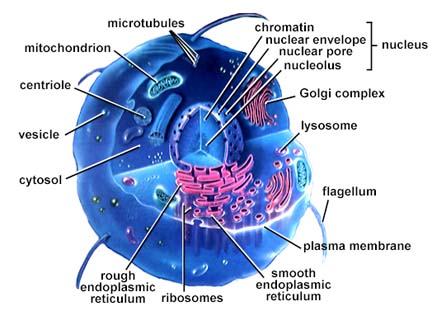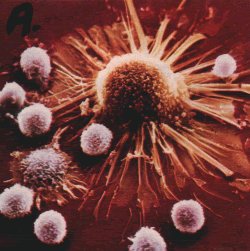
Cells:Structure and Function



Origin of concept
Hooke’s
observations of cork
Schleiden and Schwann
basic unit of life
Unicellularity vs
multicellularity
specialization
Limit in size: why? Surface
to volume ratio
Major types of cells
prokaryotic cells (lack
organelles/no
nucleus) (bacteria)
eukaryotic cells (has
organelles/has
nucleus) (protists, fungi, plants and animals)
Size of cells:
prokaryotic (~1-5
micrometers
(micrometers)) (smallest bacteria ~0.2 micrometers)
eukaryotic (~10-100
micrometers) (e.g. red blood cell in humans is 10 micrometers).
Cell Structure
plasma membrane
bilayer of lipids
selective barrier
organelles (membrane bound
structures)
(only in eukaryotes)
nucleus
genetic information
double membrane
nuclear pores
chromatin
nucleolus
chromosomes
deoxyribonucleic acid
(AT GC)
Endoplasmic reticulum (ER)
Rough ER (RER)
dotted with ribosomes
protein synthesis
Smooth ER (SER)
lipid synthesis
detoxification
Golgi Apparatus
“sorting
station”; ”postoffice”
labels and modifies
proteins
ships them off to
different
destinations in vesicles
Lysosomes
digestive organelles/
contain digestive enzymes (analogous to a stomach)
made by the Golgi
apparatus
Mitochondria
“powerhouse of
the cell”
inner/outer
membrane/matrix/cristae
generates chemical
energy
(ATP)
(Adenosine TriPhosphate)
by using cellular
respiration
Chloroplasts
site of photosynthesis
(found only in algae and plants)
(some bacteria are
photosynthetic/ bacteria don’t have organelles)
converts light energy to
chemical
energy
inner and outer
membrane/
thylakoid membrane/ grana/ stroma
contains pigments to
capture light (mainly chlorophyll)
Endosymbiotic Theory
states that mitochondria and
chloroplasts originated from bacteria
that entered ancestral
eukaryotic cells about 1.8-2 billion years ago.
Evidence:
inner membrane
similar
to bacteria
have their own
circular
DNA (like bacteria)
divides by binary
fission
(like bacteria)
their ribosomes are
similar to the ones found in bacteria (70S)
Benefit: a cell with
mitochondria generate 17x as much energy as a cell without
a cell
w/ chloroplasts can use light as energy! Advantage is obvious.
Cytoplasm
the liquid within the
cell
mainly water with a
large number of different types of solutes
Cytoskeleton
protein filaments of
different size classes spanning the interior of the cell
shape
movement
directional transport
of vesicles
Flagella/ Cilia
9+2 structure of
microtubules
responsible for
movement
cilia short version
of flagella
e.g. many unicellular
organisms such as Paramecium
e.g. in humans: sperm cells
(flagella) / oviducts and tracheae (cilia)
Plant versus Animal Cells:
plants have three unique organelles compared to animal cells
1. Chloroplast
(described
above)
remember:
plants
have both chloroplasts and mitochondria
2. Vacuole (storage
of compounds/waste/toxins/pigments)
3. Cell wall made of
cellulose
shape/strength/turgor
pressure
“cage
analogy”
none of the three
organelles
(1-3) above are present in animal cells.

| Page created
by: Peter
Svensson Updated:March 1, 2010 |